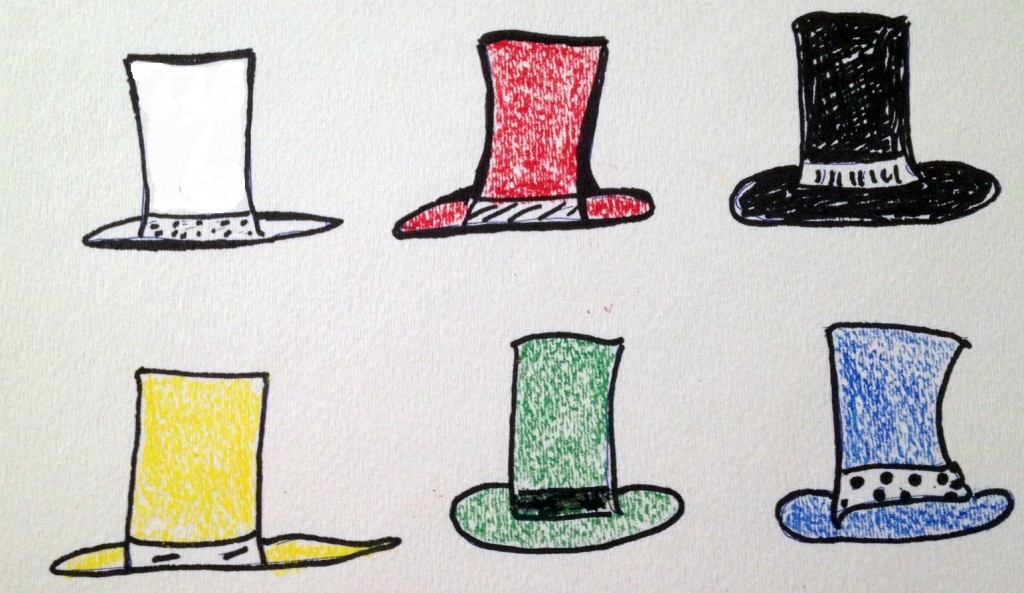I’m an old hat (pun intended) at writing workshops and want to share a system that works in the classroom, based on Edward de Bono’s Six Thinking Hats.
If you haven’t been introduced to Edward de Bono, it’s time to meet a wonderfully creative and adventurous thinker. I call him the other great Bono. Most likely you’ve come across one of those “think outside of the box” puzzles, where you must connect the dots with one line, and it seems impossible, until you see the answer, and then you realize you just had to expand your mental horizons a bit for an easy, brilliant solution.
In his book, Six Thinking Hats, de Bono explains that our business practices are mostly based on Aristotelian thinking, which is black and white, right or wrong, win or lose, and based on arguments and debate. Typically, in a business meeting, choices and decisions are based on this pattern of thinking, and it’s often the boss or someone with the loudest voice that wins the debate. The main problem with making decisions in this manner is that all thoughts and emotions about an issue are bunched and tangled into one big mess.
With Six Thinking Hats, de Bono asks participants to depart from this right and wrong mentality, thinking through problems with parallel roleplaying that untangles emotions, hope, and creativity into discrete bundles that can be viewed separately. That’s where the six hats come in. De Bono’s six hats separate thinking into six clearly defined roles, each identified with a symbolic color. You can find more information about his Six Thinking Hats on The De Bono Group website.
I’ve adapted the six hats for use in classroom workshops and have been using this method, successfully, for more than a year. Teachers, have you ever asked your students what they have to say about another student’s essay or story, and simply gotten blank stares? Or worse, the “It’s lame” comment, without any more detail than that. Once, in a Basic Composition class, a student in the front row simply said the F word, drawn out into six or seven syllables. I couldn’t resist asking, “Could you be more specific?”
Those days are over. Before we critique a student’s work, I hand out six cards to six students. Each card has a colored hat and a description of the role for that hat. If a student has the card with the yellow hat, for example, that student is responsible to begin the discussion of all things positive about the story. (It’s the best hat!)
I change the wording for the hats and their roles, depending on the class I’m teaching. For Writing for the Web students, the hats are as follows:
- White — Language and technique. Reach audience? Words stick out or fit?
- Red — Emotional impact. Does the story feel powerful?
- Black — Mechanics. Does it seem professional, or are there too many typos and other errors?
- Yellow — Positive assessment. What do you like best about the piece?
- Green — Choreography and creativity. Is the plan logical? Are the goals and actions clear? Are there any steps missing?
- Blue: Structure. Is there a clear beginning, middle and end? Does the beginning make you want to read more? Does the ending feel satisfying?
There are two more roles. The student who authored the story simply listens. Another student reads the work out loud. By hearing someone else read the work, the author can hear where words stick out. If the reader stumbles over sentences, I ask the author to see if a sentence needs revision. Also, many times the reader simply fixes errors, not even seeing them.
The six students who are holding cards while the story is read pay extra attention to their discrete role. Overall, the discussions have been both helpful and lively. Finally, if we are critiquing more than one student’s work, we simply shuffle the cards. Some students like the Black Card, but many find it to be the most challenging to talk about. I ask the students to lead the discussions, but if anyone is having trouble, I chime in or ask others to respond.
I hope you’ll try this method and let me know how it works in your class, workshop, or critique group!
More
Three minutes with Dr. Edward de Bono on Six Thinking Hats, video
